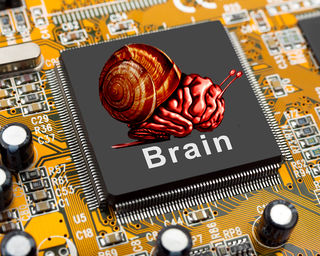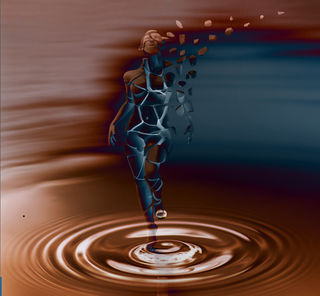
The threat of nuclear war looms. How did humans become the greatest threat to humanity? We became a social species to avoid destruction, and essentially, we're the same motley simians that first recognized by sticking together we stood a better chance of satisfying our needs. Even if we are on the brink of destruction, the rewards of membership in a social species outweigh the liabilities.
"We've come a long way…"
Our natural predators are in zoos; our homes are fully equipped for our comfort; and we determine what we eat, not the seasons. The Internet opened a bright, promising future. However, our outstanding creations in technology created an environment that is too toxic for our brains. Our biology hasn't had a CNN-worthy moment since we developed color vision during the Pliocene Epoch. If we imagine a cave man or woman trying to circumnavigate our day, we understand the challenge the old mammal brain continuously faces. This brain area, which houses emotion, relies on simple signaling mechanisms that aren't suited to our high tech world.

Could this critical disjuncture between our rapidly changing technology and static biology be the fons et origo of the disturbing events unfolding on domestic and global stages? There is something tragically ironic and very telling that the emojis and acronyms in a text message curiously resemble the wall of a cave in ancient Mesopotamia.
Consider mathematical symmetry

Mathematical symmetry classifies and distinguishes between different patterns. For example, as I said in a previous blog post, "..a pebble drops into a pond. The dissipating concentric circles appear to form a symmetrical pattern, but in actuality, the intrusion of the pebble disrupts the symmetry of the surface plane of the pond.”(1) Now think of ourselves as bits of moss that go wherever the ripple effect takes us, i.e., our birth, life journey, and inevitable destiny. Sometimes the patterns we see are not what they seem to be – like the concentric circles on the pond, truth is deceptive and dissipates.
We all fail; and without it, success wouldn't be special. Everyone experiences the same basic emotions, and actions that underwrite the current world crisis. It's not pretty, but it's what humans do. Hence, blame, like worry, is only useful for reducing stress by tricking the brain into thinking that it's being proactive and taking control.(2-6) However, like the dissipating concentric circles in the pond, the notion that we are what we intermittently think or do is inaccurate. Our thoughts are private, and yes, we are accountable for our actions, but even the Roman Catholic Church acts as an agent of God's forgiveness - are we above that?

The brain consolidates and simplifies to promote proficiency at the expense of accuracy.(7-11) That makes us vulnerable to racist, sexist, and xenophobic thoughts or behaviors, but it does not make us indelibly bad. Things are only valid in the present, whether they have consequences or not. Fretting over the past or future allows things to exist beyond their actual time and space because the past and the future are only valid when they are present. So then, is saying we, or others, are racist or misogynistic because we experience such thoughts or even act on them scientifically accurate? Aren't those terms only accurate when describing specific thoughts or actions – not people? Isn't it like saying a person is a cold, because at times he or she had a cold, or frequently get colds? We are all moss in the pond; no one ordered his or her life from Amazon. We go where the ripples take us and do the best we can.

So step one in saving our world begins with saving ourselves, by loving ourselves unconditionally. What happens in our lives is less important than our response to it. We are exactly how we're supposed to be until change occurs, and then that's how we should be. We are not the problem, believing our worth decreases because of low moments in our lives is the problem, especially if it obstructs making necessary changes. We can't expect perfection, but we must insist on the effort.
Also, we speak of society like it's a dome over a botanical garden when it's a collection of moments and occurs whenever two or more humans interact. Therefore, by directing our interactions with others, we direct society. We must bring it from within if we want a better world, but that is counterintuitive. Singling people out and demonizing them is much easier than realizing that we are all flawed and dependent on each other. We deserve to survive as a species, so then let us honor the social agreement of our ancestors, beginning with managing our private demons and clearing our unique hurdles. As always - Remain Fabulous and Phenomenal
Join my email list to receive notifications of new posts
References
1. Gordon B. 2014. Sexism's Threat to Human Health | Psychology Today. (n.d.). . Retrieved from https://www.psychologytoday.com/blog/obesely-speaking/201410/sexisms-th…
2. Hofmann SG, Moscovitch DA, Litz BT, Kim HJ, Davis LL, Pizzagalli DA. 2005. The worried mind: autonomic and prefrontal activation during worrying. Emotion 5:464-75
3. Paulesu E, Sambugaro E, Torti T, Danelli L, Ferri F, et al. 2010. Neural correlates of worry in generalized anxiety disorder and in normal controls: a functional MRI study. Psychological medicine 40:117-24
4. Ketterer MW, Lovallo WR, Lumley MA. 1993. Quantifying the density of Friedman's pathogenic emotions (AIAI). International journal of psychosomatics : official publication of the International Psychosomatics Institute 40:22-8
5. Treadway MT, Buckholtz JW, Martin JW, Jan K, Asplund CL, et al. 2014. Corticolimbic gating of emotion-driven punishment. Nature neuroscience 17:1270-5
6. Lythe KE, Moll J, Gethin JA, Workman CI, Green S, et al. 2015. Self-blame-Selective Hyperconnectivity Between Anterior Temporal and Subgenual Cortices and Prediction of Recurrent Depressive Episodes. JAMA psychiatry 72:1119-26
7. Castellano C, Cestari V, Cabib S, Puglisi-Allegra S. 1994. The effects of morphine on memory consolidation in mice involve both D1 and D2 dopamine receptors. Behavioral and neural biology 61:156-61
8. Murphy KJ, Regan CM. 1999. Low-level lead exposure in the early postnatal period results in persisting neuroplastic deficits associated with memory consolidation. Journal of neurochemistry 72:2099-104
9. Hoffman KL, McNaughton BL. 2002. Sleep on it: cortical reorganization after-the-fact. Trends in neurosciences 25:1-2
10. Moita MA, Lamprecht R, Nader K, LeDoux JE. 2002. A-kinase anchoring proteins in amygdala are involved in auditory fear memory. Nature neuroscience 5:837-8
11. McGaugh JL. 2004. The amygdala modulates the consolidation of memories of emotionally arousing experiences. Annual review of neuroscience 27:1-28


